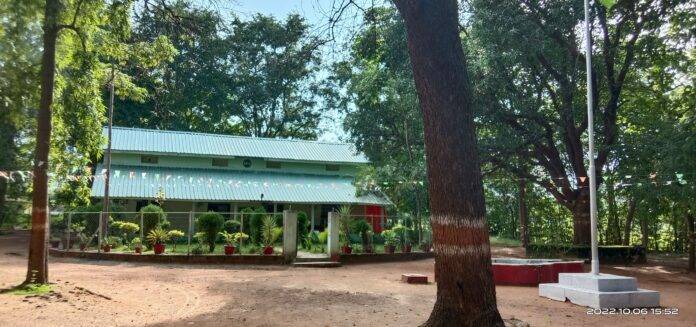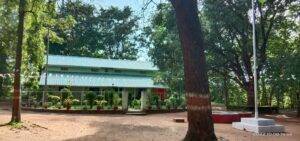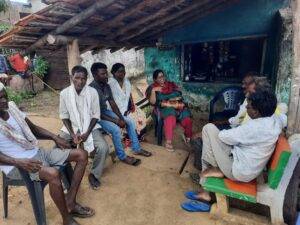
Why are Adivasis Resisting Kanhalgaon Sanctuary + EcoSensitive Zone?

Sanctuarising Adivasi Communities
There is no doubt that conservation of wildlife and environment are of prime importance, but conservation has to be balanced with the right to life and livelihood of local people especially Adivasis who worship nature and depend on the forests for their very survival. The legitimate concerns of ecological communities i.e communities who are part of the ecology, people who live close to natural resources, have a long association with the resource and who tread very lightly on Mother Earth should not be discounted.
Unfortunately, local communities do not figure as a priority at the policy level – their livelihoods and aspirations are disappearing from the policy pages. There is no answer to the questions like why were no alternative sustainable livelihood options created for the people of Kanhalgaon and neighbouring villages? In fact, why does the word ‘livelihood’ not even occur in the MoEF guidelines?
Although the government wants to give a ‘strong message’ that no day-to-day activities will be hampered due to the notification of ESZ, the ground reality appears to be that the day-to-day activities of Adivasis have already been adversely impacted due to the formation of the sanctuary. The people of Kanhalgaon who live closest to the sanctuary feel that the creation of Kanhalgaon wildlife sanctuary was their misfortune. Now they are afraid that a bad scene would be made worse by the ESZ.
In 2020 the Kanhalgaon wildlife sanctuary in Chandrapur district was announced inspite of opposition from local communities. Now, villagers of 60 villages located in the adjoining areas of Gondpipari, Pombhurna and Ballarpur talukas are opposing the demarcation of the eco-sensitive zone (ESZ) of 1 to 2 kms around the periphery of the sanctuary. In a recently concluded public hearing, all the villages opposed the ESZ. Each and every Gram Sabha included in the zone has passed resolutions placing their objections on record.
Understanding the Central Government Guidelines regarding ESZ
Eco – Sensitive Zone does not involve land acquisition or displacement but that certain activities become restricted or prohibited in the zone. According to the guidelines issued by the Ministry of Environment and Forest, govt. of India (MOEF), such eco-sensitive zones should extend upto 10 kms from the boundary of the Protected Area and in case “where sensitive corridors, connectivity and ecologically important patches, crucial for landscape linkage, are even beyond 10 kms width.”
ESZ “ are meant to act as “shock absorbers” / “transition zone” to the Protected Areas by regulating and managing the activities around such Protected Areas.” This means that this the zone of regulated human activity which lies between the Protected Area where there is practically no human activity on the one hand and the rest of the world on the other where human activity Is unrestricted.
The procedure to be adopted for demarcation of ESZ includes making an inventory of activities to be prohibited or regulated by the Range Officers within 10 kms of his Range.
A committee of officials shall be formed to suggest (i) the extent of the eco-sensitive zones for the PA being considered, (ii) the suggest the best methods for management of the eco-sensitive zones so suggested, (iii)to suggest broad-based thematic activities to be included in the master plan for the region.
Based on the suggestions the chief wildlife warden is expected to group the activities under three categories: prohibited, restricted with safeguards and permissible. Once the proposal for the eco-sensitive zones has been finalised, the same is to be forwarded to the MOEF for notification.
The guidelines state “The State Government should endeavour to convey a very strong message to the public that ESZ are not meant to hamper their day to day activities …”. This guideline appears to be in contradiction to the general purpose of ESZ which in case aims to regulate human actions and is therefore bound to interfere and hamper not just day to day activities but long term life decisions.
Prakash Kulmethe, Sarpanch, Kanhalgaon describes problems due to sanctuary (Marathi)
Why are Local Adivasi Communities Opposing the Kanhalgaon ESZ?
1) Loss of Livelihood: Kanhalgaon is a van gram – a forest village that was settled during colonial rule. There is an old rest house built in 1919 which used to be used by forest officials during the British times. Being a forest village, very few people own land and depend on forest resource and the forest department for livelihood. Since the creation of the sanctuary all forest-related activities have practically ground to a halt. Collection of minor forest produce like moha, fruits and tendu leaves is very low.
According to Prakash Kulmethe, the Sarpanch of Kanhalgaon and leader of Gondwana Ganatantra Party, “The forest department used to give work to thousands of people in more than forty village but now all the work in the nurseries, plantations, bamboo cutting has stopped. Men and even women have migrated in search of work. Neither the government nor the environmentalists who supported the sanctuary have given us any alternative work.”
Parmeshwar Karewar, the officiating RFO, Jharan explains, “The Kanhalgaon sanctuary stands on 270 sq km of forest land all of which was acquired from fore department. The land of five forest ranges were acquired for this sanctuary and this has hit the livelihood of the local people very hard. Jharan range had 8000 ha of forest and provided work to villagers from Ganpur, Kothari, Bhatari, Dewai, Chintaldhaba, Kemara, Bamni and Tohogoan. Between October and March, our monthly account went up to Rs. 15 lakhs but now it does not cross even a couple of lakhs annually.”
This story is repeated in the other four ranges – Kanhalgaon No. 1, Kanhalgaon No. 2, Dhaba and Tohogaon. Together these five ranges ensured that Adivasis had work for ten months in a year but now there is a severe shortage of work in the area.
2) Potential Loss of Income through ESZ: There is a fear that local people will not be able to set up industries or change the crops they grow without permission from the government. Since the list of restricted activities included in the guidelines is only indicative, this may grow and new activities may be added to it.
3) Other Restrictions: The local communities are wary that they will not be allowed to drive vehicles are night, fell trees on their own agricultural land and roads will not be built in the area without permissions. Overall the very thought of seeking permissions is stifling and they feel that it will only increase harassment and slow down infrastructure development in an already backward area.
4) Wary of extension of the Zone: Although the forest department has presently proposed ESZ of 1-2 kms, the villager are afraid that it will be extended to 10 kms in the future and all development activities in the area will stop.

Perspective of Forest Department
According to Swetha Boddu, Deputy Conservator of Forest, Central Chanda Division, the ESZ has already come into “de facto” existence since the formation of the sanctuary and the on-going processes for notification are mandatory. She is aware and upfront about the resistance of the villagers and explains, “We are not giving any benefits through the ESZ but we since people are opposed we may reduce the non-forest area included in the zone.”
The proposed ESZ includes 31606.54 ha of land of which 16613.34 ha i.e. approximately 50% of the land is non-forest land meaning it belongs to farmers, gram panchayats etc. There are some villages where much of the land included in the ESZ belongs to the ‘non-forest’ category. For instance in Ganpur 225 ha out of 284 ha is non-forest land. In other villages like Chak Somanpalli, Polsa, Chak Gojoli, Bhatari and Chak Pargaon the entire land being brought under ESZ is of the non-forest category.

– Paromita Goswami


